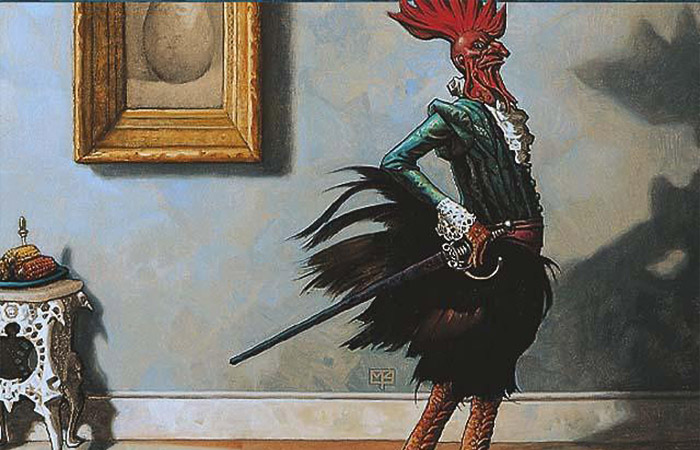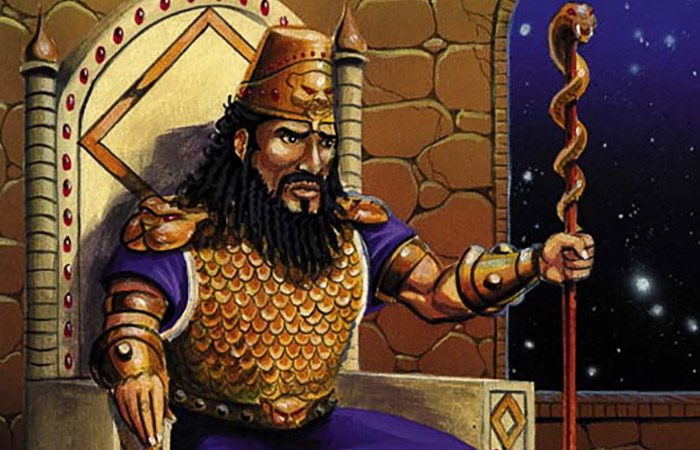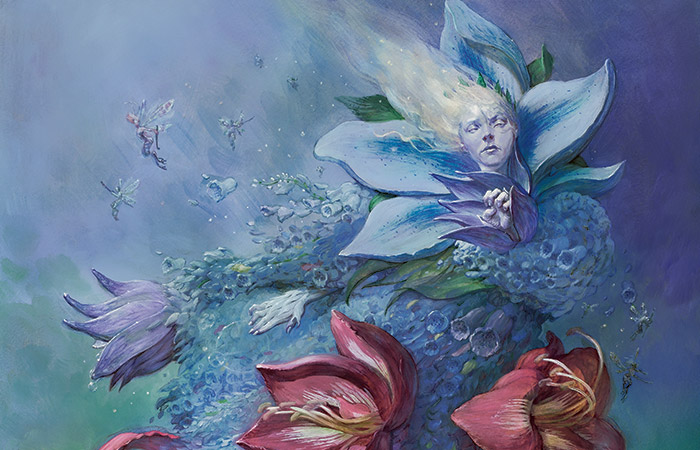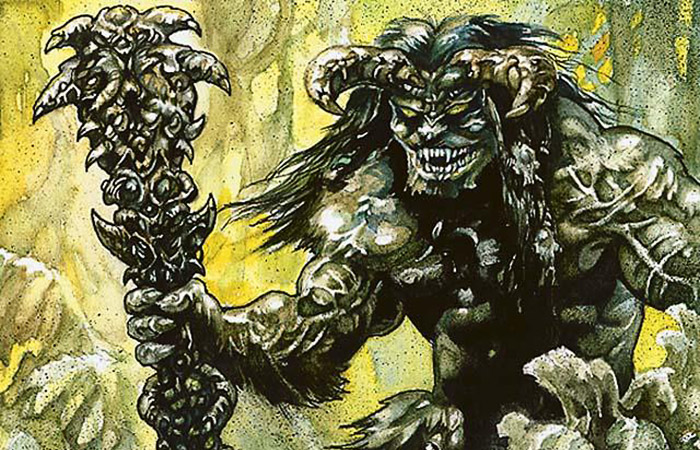Kings & Things
It's Kings, Presidents, and Khans Week, where we'll exploring leaders of different types. I thought it might be fun to look back at some of the leaders of Magic's past and explore aspects of how their cards got made (and one that didn't).

Chicken a la King | Art by Mark Zug
Chicken a la King (Unglued)
When Unglued design started, it didn't have any mechanical themes. It was going to be silver-bordered and not for tournament play. It was going to be silly in flavor and do a lot of things black border just couldn't do mechanically, but the set didn't have any connective theme. Partway through design, I realized that a little Chicken theme had started. I had a few creatures that were Chickens and some of the early card concepting involved some ideas with chickens in the art. Hey, Unglued could have a theme, and chickens seemed as good as any.
I was actually stopped in the hallway at one point by the then head designer, a man named Joel Mick, who asked me "Are chickens funny?" I then had to explain the long history that chickens had with comedy, using such examples as the rubber chicken. Joel walked away content.
So, part of making a chicken theme was making a cycle of Chickens. One of them, though, needed to be a Chicken lord so players could build a Chicken deck. (If I was doing this today, I would have concentrated more Chickens in a few colors to make it easier to build the Chicken deck, but this was the early days and I hadn't quite figured that out yet.) One day at home, I was talking with my then-girlfriend and now-wife, Lora, about the need for a leader of the chickens. Lora came up with the name Chicken a la King and I remember saying, "That is now the name of the card."
It turns out another big theme of the set was dice rolling (six-sided dice in particular) and three of the four other Chickens all used dice rolling, so I decided to connect Chicken a la King to dice rolling. This allowed the card to work in a Chicken-themed deck, a dice-rolling-themed deck, or—my favorite—a chicken- and dice-rolling-themed deck.
Originally, the card only put the +1/+1 counters on Chickens if a 6 was rolled. I realized that I needed to make sure there was a way this card in isolation could work, so I added the ability to tap a Chicken to roll a die. That meant that even this card all by its lonesome could work.
I spent a lot of time working on the flavor text for this card. I really wanted to capture the essence that the Chicken a la King was the leader of his people but also that he was a chicken. I was very happy with the flavor text I came up with, which had an awesome tone, gave a little backstory to the chickens, and created a joke that takes the reader a second to click together.
And that is how a chicken lord was made.

King Suleiman | Art by Mark Poole
King Suleiman (Arabian Nights)
Innistrad had a number of cycles in every color except white to represent the monsters surrounding the humans on all sides. Interestingly, Innistrad was not the first Magic set to make a cycle out of four of the five colors. That honor goes all the way back to the first Magic expansion, Arabian Nights. In it, Richard Garfield made two cycles—one of Djinns and the other of Efreets. Both cycles had a card in blue, black, red, and green. Then, to balance this cycle, Richard made King Suleiman, a creature that could tap to destroy a Djinn or Efreet. In the early days, white was a little more proactive about killing the things it saw as "evil."
King Suleiman is most likely based off of the biblical King Solomon. In stories, Solomon was granted a copper and iron magic ring that allowed him to subdue a mythical djinn. The djinn then stole back the ring while Solomon was bathing, but in the end Solomon was able to get his ring back and re-subdue the djinn. He eventually trapped it in a bottle. This event is represented by a second card in Arabian Nights, Bottle of Suleiman, which was an artifact that allowed you to either summon a Djinn or take 5 damage.
The spelling of King Suleiman probably came from Suleiman the Magnificent, the tenth and longest-reigning Sultan of the Ottoman Empire, from 1520 to 1566. Under his patronage, the Ottoman Empire was considered to have entered the Golden Age in its cultural development. (Thank you Wikipedia.)

Olivia Voldaren | Art by Eric Deschamps
Olivia Voldaren (Innistrad)
This card's design came about because I thought it was important that the Vampires have their own leader. One design meeting, I started by writing "Count Dracula" on the whiteboard. "Today," I said, "We're making the lord of the Vampires."
We spent some time talking about what the lord of the Vampires should do. The design team liked the idea that the creature would feed on other creatures and either kill them or turn them into Vampires. The tricky part, though, was how exactly to execute this mechanically. Eventually, we came across the idea of representing feeding by dealing damage to the victim and Count Dracula getting stronger. What if this ability had one extra component, though? What if, in addition to the damage, it turned the victim into a Vampire?
This way you could kill a creature by feeding on it or, if you showed restraint, you could turn it into a Vampire. The next question was why would you want to? Meanwhile, we were playing around with the idea that the creature would have two abilities, one red and one black (as the Vampires in Innistrad block were black and red). Traditionall,y feeding has been done in black (mostly because Vampires are done in black), but as you were essentially doing direct damage, we put the ability in red. This meant the black ability had to be something black could do.
As we played around with the flavor, it became clear. The lord of the Vampires should be able to lure other Vampires to your side. Normally, blue is the creature-stealing color with red getting temporary stealing, but black gets creature stealing every once in a while. This was meant to be a high-profile card. If black got it in special cases, this was a special case. The second ability was flavorful and very synergistic with the first ability. We had found our Count Dracula.
The story doesn't end there though. While I was a big fan of the card, Mark Gottlieb, who was still the rules manager (he transitioned out during the tail end of Innistrad development) was not a fan of the execution. He didn't like the memory issue of turning creature into Vampires and felt that constantly stealing would be too much. He and I argued endlessly about it. The design file was handed off the way I liked it and once in development the rare poll was taken. The rare poll is a tool used by development where we show rare and mythic rare cards from a set to Magic players all over Wizards to get their first impressions. Count Dracula won the rare poll. That convinced me I had made the right call.
We knew when we named it Count Dracula that the name would not stay. I just used it to make sure that everyone got the trope we were going for. The creative team then came up with a cool idea of gender swapping the trope. What if the lord of the Vampires in Innistrad was female? And Olivia Voldaren was born.

Oona, Queen of the Fae | Art by Adam Rex
Oona, Queen of the Fae (Shadowmoor)
Hybrid cards are hard to design. Blue-black hybrid cards are very, very hard to design. Why? Because hybrid cards play in the space where two colors mechanically overlap. Of the ten two-color pairs in the game, which ones overlap the least? Blue-red and blue-black. That made designing this card a real challenge.
Faeries showed up in Lorwyn in blue and black and were vile, nasty little creatures. Then the Great Aurora came and everything changed. Well, almost everything. Faeries were still blue and black and still vile, nasty creatures. Oona was their queen. Oona had been part of the story the entire year long, so we knew there was going to be a lot of interest in her card.
So, we had to capture the flavor of the queen of the faeries and we had to do so using a blue-black hybrid card. Why did she have to be hybrid? Because Shadowmoor was THE HYBRID SET, where half of the cards were hybrid, and that meant we wanted most of the high-profile cards—especially most of the legendary creatures—to be hybrid. Also the Faeries were blue and black and we wanted their leader to be playable with either color.
We started by knowing we wanted her to fly. The vast majority of the Faeries flew, so we knew the queen of the Faeries needed to fly. Blue and black both have flying. We then decided that we wanted Oona to be able to create Faeries. Token making is something all colors can do, so the overlap worked just fine. As the tokens would be Faeries—Rogue Faeries it turned out—we chose to have them fly. We made the tokens blue-black because color mattered in the Shadowmoor block and they were made by Oona, who was herself blue-black.
One of the few areas where blue and black overlap is "milling" (i.e., putting cards directly from the library into the graveyard). Usually, blue mills off of the top of the library and black goes after specific cards within the library, but each color is secondary in the other color's primary effect. At first we were thinking of having two abilities, one token-making and one milling, but they just felt too disconnected. What if we combined them? What if there was a way to make milling somehow result in Faerie tokens?
That led us to the idea that we would mill the opponent and then have some criteria we were looking for that would determine when we got a Faerie token. Shadowmoor had a "color matters" theme, so choosing a color felt right. The final decision was to put an X in the activation cost so Oona's controller could mill more and more cards, and make more and more Faeries, as the game progressed. Oona has gone on to become a very popular commander, so I'm happy we were able to crack our design puzzle in such a satisfying way.
Sidar Kondo (Vanguard)
I tell the story all the time of cards that got made but I don't often tell ones of cards that didn't. Sidar Kondo was a leader of a tribe in Jamuraa. He is probably best known, though, as the father of two boys, one biological and one adopted. His biological son was named Vuel, but you all might know him better by the name he took when he traveled to Rath, where he become Vuel of Rath or Volrath. Volrath was the major villain at the beginning of the Weatherlight Saga and was a major player in the Tempest block.
Sidar Kondo's adopted son was Gerrard, the hero of the Weatherlight Saga. Gerrard was destined to fulfill a great prophecy, and to keep him safe from those that might harm him, he was sent off as a baby to Sidar Kondo. Sidar Kondo was not a major character but he was significant enough that when we were making Vanguard cards back in the day, we made him one. This story isn't about that card, though, this is about the legendary creature card I made for Time Spiral.
Time Spiral had a time theme centered in the past and a strong nostalgic element, so we were going out of our way to create legendary creatures of characters we never had a chance to make cards of. Most of the Weatherlight characters had cards, so I was trying to figure out which ones didn't. Sidar Kondo seemed like a good choice. He was the only Vanguard card (covering the initial part of the Weatherlight Saga—meaning the first three sets) not to have a legendary creature card.
I designed him and then the creative team decided not to put him in the set. Now, the set had major characters like Mishra and Teferi, and some fan favorites like Jaya Ballard, but it also had more minor characters like Ith, Ib Halfheart, and Mangara. I had even managed to personally get both Saffi Eriksdotter and Norin the Wary in the set and those were both based off of flavor text. They just felt Kondo wasn't well enough known. He was a Vanguard card, I countered, but to no avail. And thus, Sidar Kondo never became a legendary creature.
Perhaps one day…

Sliver Queen | Art by Ron Spencer
Sliver Queen (Stronghold)
Sliver Queen has the honor of being Magic's first ever five-colored card. (Okay, "first printed and available in a booster" five-color card. Technically, we did make the 1996 World Champion card, but there was only one of those.) She is also the leader of one of Magic's most popular races, the Slivers. Here's how she came to be.
The Slivers were first created in a set called "Astral Ways," a homebrewed set made by a man named Mike Elliott. Mike would later go on to join R&D and be one of the most prolific designers (Mike still holds the record for the most design team leads after myself). Mike and I joined R&D as developers but both of us were interested in becoming designers. With Richard Garfield's help, I talked my way into being the design lead for the set Tempest. I was allowed to select my team, so I chose Mike, knowing that he was eager to design.
When Mike was hired, R&D purchased the "Astral Ways" set from Mike, so he turned in many cards from it in Tempest's design. One series of creatures were called the Slivers and they represented pieces of a singular character (some kind of god, if I remember correctly) who fell to earth from the heavens and split into many pieces. The original names for the Slivers were all pieces of that creature's body. The most impressive one represented the creature's brain:
Mind of the Controller (rare)
WUBRG
Summon Legend
Gold
7/7
Trample
All Slivers get +1/+1
The Slivers had mechanically been inspired by the card Plague Rat from Alpha. Mike liked how the card played and had designed a race of creatures to all have a similar effect, except instead of one creature, there were a race of creatures. We played with the Slivers and quickly realized we had a hit on our hands. The problem was that Mike had so many Slivers that we were going to have to divvy them up.
Meanwhile, while the design was going on, I was busy working with a man named Michael Ryan putting together the Weatherlight Saga. Michael and I felt the game was missing a grander story, so we created a cast of characters and a storyline to run over many years. While working on the Tempest storyline, Michael and I knew we had to figure out how to make the Slivers part of the story.
We ended up making them an alien race from another plane (as yet unknown—perhaps we'll discover it one day). Volrath, the villain of the story, discovered them and brought them to Rath to study. Like Volrath, these creatures were also shapeshifters, and they shared a hive mind. As long as they were close enough to one another they could share their collective thoughts. If one Sliver, for example, knew how to shapeshift a pair of wings, every Sliver near it knew the same things and thus could fly. The Metallic Sliver in Tempest, by the way, was an invention built by Volrath to spy on the Slivers. That is why it is the only one to receive and not grant any abilities.
We had made the choice to push back the five-colored Sliver to the second set of the block, Stronghold. Michael and I knew the first-ever five-color legendary creature had to be special. Just as Mike had made it the brains of the group, so too did Michael and I realize it needed to be their leader. The creatures shared a hive mind, so we followed that lead and modeled the Sliver Queen after a queen bee. She was the one that birthed the Slivers (well, this batch anyway—while it goes unsaid in the story, Volrath captured the Sliver Queen and she is where all the Slivers on Rath came from).
Here is the card as it appeared in Stronghold design:
Mind of the Controller
WUBRG
Summon Legend
Gold
7/7
Trample
Counts as a Sliver
3: Put a Sliver token into play. Treat this creature as a 1/1 colorless creature.
I don't remember if the Sliver-making was first done mechanically by Mike and then reflected in the story or the story inspired us to tweak the design (my guess is the former), but we ended up setting up the Sliver Queen as a Sliver maker.
In the story, when Volrath (through henchman Greven il-Vec) captures the Legacy—the collection of magical devices Gerrard needed to fulfill his destiny—Volrath had it guarded by the Sliver Queen. Karn ended up finding the Sliver Queen and explained to her that the Legacy is to him as the Slivers are to her (Karn was the guardian of the Legacy as well as being a piece of it) and she let him take it.
The card says "Sliver Queen counts as a Sliver" on it because, at the time, creatures could only have one creature type and legend was a creature type and not yet the supertype legendary. Trample got removed during development because it proved a little too much. Also, the goal of the Sliver Queen was not to beat down with her but to make lots and lots of Slivers.
The Sliver Queen went on to become an all-time fan favorite and has inspired numerous other five-colored Sliver lords. For more on the history of the Slivers, you can read my article from Sliver Week ("Sliver Me Timbers" from all the way back in 2004).

Sol'kanar the Swamp King | Art by Richard Kane Ferguson
Sol'kanar the Swamp King (Legends)
I'm going to end today with one of my favorite playtest stories of all time. It was a Time Spiral playtest and I was playing against former Magic developer Devin Low. At the time, we had a mechanic in the set that allowed you to tap certain cards two times. Here's how it worked. A creature with the double-tap symbol could be tapped twice within one turn. First time you tapped it normally, tapping it ninety degrees. You could then tap it again, turning it essentially upside down. Creatures only untapped one rotation during untap, so if you double tapped it, it would take two turns to untap fully. Obviously, this mechanic had to use abilities where there was an advantage to tapping it twice on the same turn.
One such card was a black creature that tapped to essentially do what Cabal Therapy does—you name a nonland card, the opponent reveals his or her hand and then discards all copies of the named card. As the opponent has to show you his or her hand, the second tap was very valuable because you knew what they had. This made the first tap a Cabal Therapy and the second tap a Coercion, and one that could hit multiple copies of the same card.
A quick aside. This mechanic obviously never made it into the set. While novel, it proved to be hard to design to and the play pattern ended up being boring—players tapped twice the first turn and then just tapped it once for the rest of the game.
Anyway, it was getting to later in the game and it was clear that Devin was building up to something big. He had just two cards in his hand and cast one of them to search his library for two lands and put them into play tapped. (I don't think that card made it either—ah, playtesting.) Devin then made some comment about how I'm in trouble next turn.
So I played the black double-tapping creature. I had some way to give it haste so I could tap it right away. Now, remember, the first time I tapped it I was just guessing a card. Devin only had one threat, so the point of the first tap was just to see his hand and then, on the second tap, I could name the actual threat.
For those unfamiliar with Time Spiral, it was a giant set. Not only was it a large set but back in the day our large sets used to be even bigger than the ones today. Also, Time Spiral had what was known as a timeshifted sheet, which was 121 cards from Magic's past. Aaron Forsythe was on the design team and had been assigned the task of compiling the timeshifted sheet, and it was constantly changing, so I had no idea from playtest to playtest what was on it. A large main set with an ever-changing timeshifted sheet meant that the number of possibilities that the card could be was huge. It could have been pretty much any card throughout the existence of Magic.
Luckily, the initial guess didn't matter because of the double-tap. So when Devin said, "What's your guess?" I was just screwing around. "I don't know I said, "Sol'kanar the Swamp King"—chosen mostly because it's a fun card to name. Last I checked, it wasn't even on the timeshifted sheet, but it didn't matter because I was just screwing around.
Devin got a surprised look on his face and said, "Got me!" He then discarded a Sol'kanar the Swamp King. I figured that was the closest I was ever getting in Magic to a hole-in-one so I did a victory lap around the Pit.
And that is the story I think of whenever I see Sol'kanar the Swamp King.
President and Accounted For
That's all the stories I have for today. I hope you enjoyed the little jaunt through the history of some of the great leaders of the game. As always, I would love to hear any feedback. You can write me through my email or any of my social media (Twitter, Tumblr, Google+, and Instagram).
Join me next week when we finally finish off our Tarkir clan theme weeks with Temur.
Until then, may you find a reason to do a victory lap around your own Pit.
"Drive to Work #200—Black-Red"
This is the third podcast in my series on two color-pairs. Today I explain how black and red intermix.
"Drive to Work #201—10 Things—Interaction"
This is the third podcast of my "10 Things Every Game Needs" series. Today, I talk about the importance in a game of interaction.
- Episode 201 10 Things - Interaction (18.3 MB)
- Episode 200 Black-Red (14.8 MB)
- Episode 199 Feedback (16.5 MB)
- Episode 198 Holiday Cards (16.9 MB)
- Episode 197 Play Testing (14.1 MB)
- Complete Drive To Work Podcast Archive

